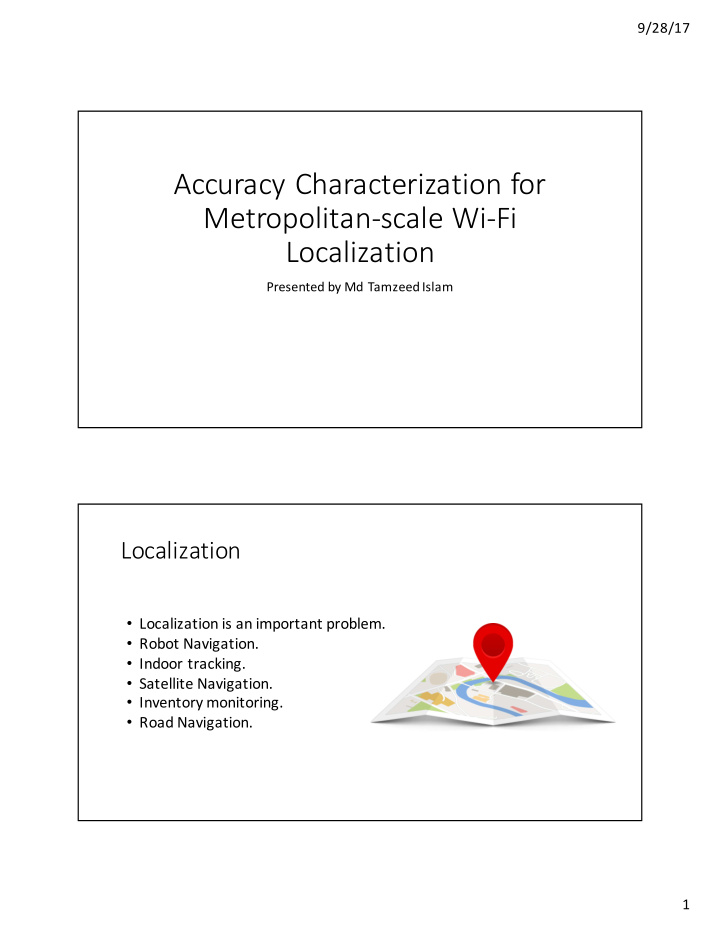



9/28/17 Accuracy Characterization for Metropolitan-scale Wi-Fi Localization Presented by Md TamzeedIslam Localization • Localization is an important problem. • Robot Navigation. • Indoor tracking. • Satellite Navigation. • Inventory monitoring. • Road Navigation. 1
9/28/17 Current Methods • Global Positioning System (GPS) • Requires a clear view of its orbiting satellites. • Constrained to outdoor environments. • Does not work indoors . • Works poorly in big cities. Current Research • Only works in limited indoor environments. • Requires considerable effort to deploy on a significantly larger scale. • Not ubiquitous and scalable. 2
9/28/17 Idea • How accurately a user’s device can estimate its location using existing hardware and infrastructure and with minimal calibration overhead? • Goal: • maximizing coverage across entire metropolitan areas. • utilizing pre-deployed hardware. No deployment • It relies on commodity hardware. • 802.11 access points. • On the client side: it uses 802.11 radios built into users’ devices . • Works both indoor and outdoor. 3
9/28/17 Work Principle • A client device listens for radio beacons. • Then, it uses a pre-computed map of radio sources in the environment to localize itself. Wi-Fi is everywhere • No new infrastructure • Low cost • “War drivers” already build AP maps • Significantly cheaper and time efficient than other calibration techniques. 4
9/28/17 Training phase. • War Driving: • Driving around a neighborhood with a Wi-Fi-enabled laptop and an attached GPS device. • The Wi-Fi card periodically “scans” its environment to discover wireless networks while the GPS device records the latitude-longitude coordinates of the war driver when the scan was performed. • After training phase: A “radio map” of the neighborhood is built. Training Data • A sequence of measurements: • <GPS coordinate, Wi-Fi scan composed of a sequence of readings, one per access point heard during the scan> • Each reading records the MAC address of the access point and the signal strength with which it was heard. 5
9/28/17 Metrics for Positioning • Observed signal strength : • Attenuation Problem due to the number of walls crossed, the composition of those walls and multi-path effect. • Not suitable for dynamic environment. Metrics for Positioning • Response rate: • The percentage of times that a given AP was heard in all of the Wi-Fi scans at a specific distance from that AP . 6
9/28/17 Centroid • Training phase: • combine all of the readings for a single access point • estimate a geographic location for the access point by computing the arithmetic mean of the positions reported in all of the readings. • radio map for this algorithm has one record per access point containing the estimated position of that AP . • Algorithm: positions the user at the center of all of the APs heard during a scan by computing an average of the estimated positions of each of the heard APs. Fingerprinting • At a given point, a user may hear different access points with certain signal strengths. • <Access Point, signal strength>: “fingerprint” • It is unique to that position. • A measurement is compared with the training measurements to find the closest match (Euclidian distance) using k-nearest-neighbor. • Final Position: Averaging the latitude-longitude coordinates of the k nearest neighbors. 7
9/28/17 Heuristics • Same set of AP is required. • For dynamic environment: • Omitting unseen AP from test scan. • Using superset or subset of Aps from the radio map. Measurement Discrepancy • WiFi devices may vary for training and testing phase. • Ranking instead of direct signal strength. • Compares lists of access points sorted by signal strength. • (SS_A,SS_B,SS_C)=(−20, −90, −40) • ( R_A , R_B , R_C ) = (1, 3, 2). • Spearman rank-order correlation for comparison. 8
9/28/17 Particle Filters • Represents the location estimate of a user at time t using a collection of weighted particles # ,𝑥 " # • 𝑞 " # = hypothesis about the user’s current position. • 𝑞 " # = likelihood that this hypothesis is true. • 𝑥 " • Two input models: a sensor model and a motion model. Particle Filters • Sensor model: estimates how likely it is that a given set of APs would be observed at a given location. • The motion model’s job is to move the particles’ locations in a manner that approximates the motion of the user. • 2 sensor models: a) signal strength, b) response rate • Sensor model determines a particle’s likelihood as follows: “for each AP in the scan, we look up the response rate or the probability of seeing the measured signal strength based on the distance between the particle and the estimated AP location in the radio map.” • Motion model: moves particles random distances in random directions. 9
9/28/17 Data Collection • Downtown Seattle: • Seattle’s Ravenna neighborhood • Kirkland, Washington Analysis of trace data 10
9/28/17 Relative performance T able: Median error in meters for all algorithms across the three areas. Effect of Aps per scan 11
9/28/17 Effect of AP Turnover • AP Turnover: the percentage of APs that are deployed but are not part of the training data. Effect of noisy GPS data • How robust the algorithms are to errors in the measured positions of the training data. 12
9/28/17 Density of mapping data Indoor Usage 13
9/28/17 Comments • The radio-map can be error prone. • Indoor result not well presented. • Accuracy in the range of 13–40 meters. 14
Recommend
More recommend